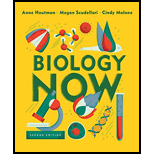
Concept explainers
An ecosystem is comprised of a group of living organisms (microorganisms, animals, and plants) and non-living organisms (water, air, and mineral soil). The ecosystem does not possess a well-defined physical boundary. Ecologists state the ecosystem in different ways based on its functions, particularly how the nutrients and energy are assimilated and disseminated by the living organisms.
Answer to Problem 1TQ
Nutrients continuously traveled between the living things (biotic) and non-living things (abiotic). The movement of nutrients among various organisms as well as the physical environment is known as nutrient cycling. Therefore, option (a) is correct.
Explanation of Solution
Justify reasons for the correct statement:
Chemicals essential for effective growth and survival of the organisms in an ecosystem are referred as nutrients. A nutrient cycle is the continuous movement of nutrients from the physical surroundings into a living organism. Later, the nutrient is reprocessed back into the physical environment. Therefore, the movement of nutrients between physical environment and the living organism is termed as nutrient cycling.
Option (a) is given as “nutrient cycling”.
Hence, option (a) is correct.
Justify reasons for the incorrect statements:
Option (b) is given as “ecosystem services”.
Ecosystem services are categorized into four types. They are provisioning (water and food production), regulating (climate and disease control), cultural (recreational and health benefits), and supporting (oxygen production and nutrient cycles). Therefore, it is not directly associated only with the nutrient cycle. Hence, it is a wrong answer.
Option (c) is given as “net primary productivity”.
The rate at which plants generate net essential chemical energy in an ecosystem is referred to as a net primary productivity. Therefore, it is not related to the nutrient cycle. Hence, it is a wrong answer.
Option (d) is given as “decomposition”.
It is the process of decay or rotting, which is achieved by the breakdown of complex organic compounds into simpler organic forms. Hence, it is a wrong answer.
Hence, options (b), (c), and (d) are incorrect.
The movement of nutrients between organism and the physical environment is termed as nutrient cycling.
Want to see more full solutions like this?
Chapter 21 Solutions
Biology Now (Second Edition)
- Please identify the curve shown below. What does this curve represent? Please identify A, B, C, D, and E (the orange oval). What is occurring in these regions?arrow_forwardPlease identify the test shown here. 1) What is the test? 2) What does the test indicate? How is it performed? What is CX? 3) Why might the test be performed in a clinical setting? GEN CZ CX CPZ PTZ CACarrow_forwardDetermine how much ATP would a cell produce when using fermentation of a 50 mM glucose solution?arrow_forward
- Determine how much ATP would a cell produce when using aerobic respiration of a 7 mM glucose solution?arrow_forwardDetermine how much ATP would a cell produce when using aerobic respiration to degrade one small protein molecule into 12 molecules of malic acid, how many ATP would that cell make? Malic acid is an intermediate in the Krebs cycle. Assume there is no other carbon source and no acetyl-CoA.arrow_forwardIdentify each of the major endocrine glandsarrow_forward
- Come up with a few questions and answers for umbrella species, keystone species, redunant species, and aquatic keystone speciesarrow_forward19. On the diagram below a. Label the three pictures as: DNA; polypeptide; or RNA. b. Label the arrows as: translation or transcription/RNA processing. c. Add the following details to the diagram. Promoter region TATA box Transcription start site Transcription terminator Intron (A,B,C,D) Exons (1,2,3,4,5) Splice sites 5' cap 5' UTR (untranslated region) 3' poly A tail 3' UTR (untranslated region) Translational start (AUG) Translational stop (UGA, UAG, or UAA) N and C ends of polypeptide 0000arrow_forwardMatch the letter labels in the figure below to the terms. Some letter labels are not used. MNNNNNNIN M C B A M D F E H K G 8arrow_forward
 Human Anatomy & Physiology (11th Edition)BiologyISBN:9780134580999Author:Elaine N. Marieb, Katja N. HoehnPublisher:PEARSON
Human Anatomy & Physiology (11th Edition)BiologyISBN:9780134580999Author:Elaine N. Marieb, Katja N. HoehnPublisher:PEARSON Biology 2eBiologyISBN:9781947172517Author:Matthew Douglas, Jung Choi, Mary Ann ClarkPublisher:OpenStax
Biology 2eBiologyISBN:9781947172517Author:Matthew Douglas, Jung Choi, Mary Ann ClarkPublisher:OpenStax Anatomy & PhysiologyBiologyISBN:9781259398629Author:McKinley, Michael P., O'loughlin, Valerie Dean, Bidle, Theresa StouterPublisher:Mcgraw Hill Education,
Anatomy & PhysiologyBiologyISBN:9781259398629Author:McKinley, Michael P., O'loughlin, Valerie Dean, Bidle, Theresa StouterPublisher:Mcgraw Hill Education, Molecular Biology of the Cell (Sixth Edition)BiologyISBN:9780815344322Author:Bruce Alberts, Alexander D. Johnson, Julian Lewis, David Morgan, Martin Raff, Keith Roberts, Peter WalterPublisher:W. W. Norton & Company
Molecular Biology of the Cell (Sixth Edition)BiologyISBN:9780815344322Author:Bruce Alberts, Alexander D. Johnson, Julian Lewis, David Morgan, Martin Raff, Keith Roberts, Peter WalterPublisher:W. W. Norton & Company Laboratory Manual For Human Anatomy & PhysiologyBiologyISBN:9781260159363Author:Martin, Terry R., Prentice-craver, CynthiaPublisher:McGraw-Hill Publishing Co.
Laboratory Manual For Human Anatomy & PhysiologyBiologyISBN:9781260159363Author:Martin, Terry R., Prentice-craver, CynthiaPublisher:McGraw-Hill Publishing Co. Inquiry Into Life (16th Edition)BiologyISBN:9781260231700Author:Sylvia S. Mader, Michael WindelspechtPublisher:McGraw Hill Education
Inquiry Into Life (16th Edition)BiologyISBN:9781260231700Author:Sylvia S. Mader, Michael WindelspechtPublisher:McGraw Hill Education





